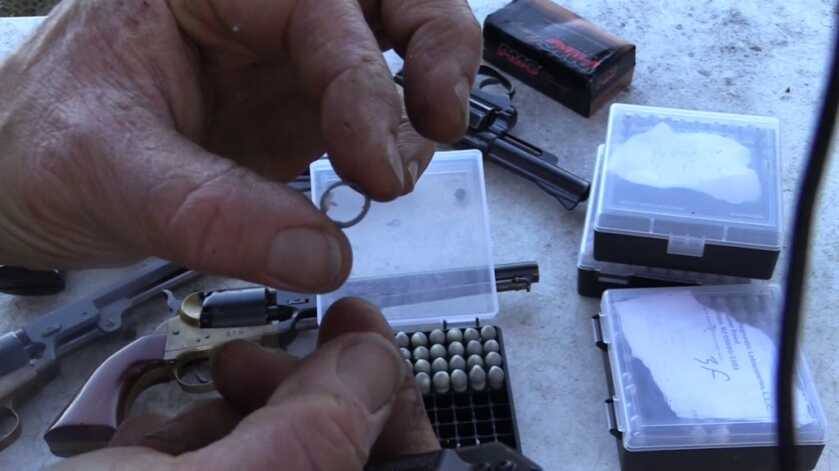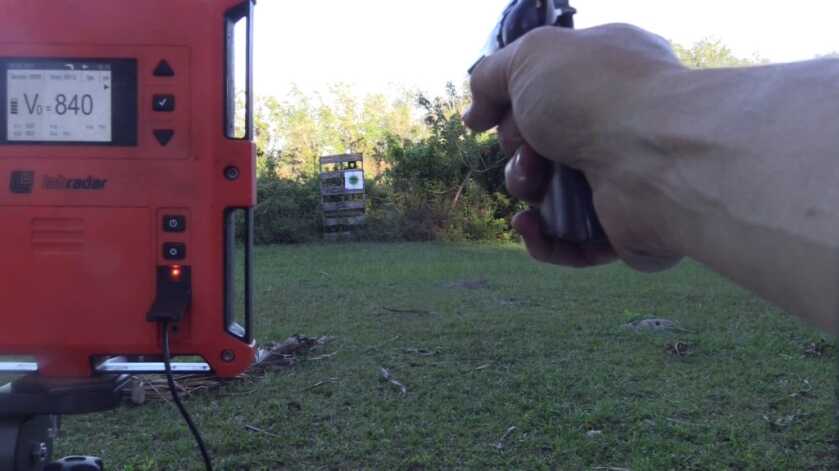
Eras Gone Richmond Labs Mold – Limited supply at Eras Gone
Star & Bullock Hardware – 36 caliber cartridge forming kits
To me, guns are guns. They aren’t toys. They aren’t tools. And whether I am going to carry them for self defense, shoot them in competition, the measurement of a gun boils down to the ballistics. Is it an effective weapon for killing…whatever it is you might need to kill. Guns are the single most influential element in the evolution of our civilization. G-d made man, but Sam Colt made them equal.
The 36 caliber cap and ball revolver dates back to the very first revolver released by Sam Colt, the Paterson. That is an oddball gun, but the caliber continued into mass produced guns, and were extremely popular in several models of Colt, Remington, and most of the small contract manufacturers during the war of Northern aggression.
I do not collect original guns, mostly due to the overwhelming amount of fraud out there in them, but I love the Italian copies, and it all started with the 1851 Navy you see here, purchased in the 1980s for probably $75 or less. I shot that gun for many years in SASS Cowboy Action shooting (I am SASS#19811), and always loaded it and the Griswald also shown here right up to snot. Colt never actually made a brass frame gun, but they have served me well for thousands of rounds, and even though I grew up in New Hampshire, I think I was always Johnny Reb at heart anyway.

My problem with the 36 has always been that I don’t feel it has sufficient knock down power to be worth carrying. The .375 roundball that you use in these guns only weighs 80 grains, so it is like a weak 380 ACP. I am well aware that most handguns are not actually capable of knocking a man down, unless you hit the central nervous system. But if I am going to carry a gun, I am going to be looking for more bite than just bark. Therefore, when I have carried a cap and ball revolver for self defense, where there was a loophole in the carry laws, I have always carried a .44.

Enter the Eras Gone Richmond Labs bullet. It changes the whole game for these 36 caliber guns. Weighing in at about 150 grains, this bullet is in the same weight class as the most common 38 Special bullets. And people can say what they want about 38 Special. It is a man killer and it served as the main law enforcement caliber in the US for many decades. The only downside to the bullet I would say is that they are very difficult to “ring” when you compress the bullet into the .375 chamber. At it’s widest point, the Richmond is .390, so you get a real ring that has to be hand shaved with the loading lever. On shorter barrel guns it is especially tough.

The actual diameter of a 36 cap and ball revolver is the same as a 38 Special also, .357 inches. So this is a real apples to apples comparison. These days you seldom see the traditional 147 grain load, but it generally was around 900 feet per second in a 5″ barrel gun.
Faster is considered better these days, because a generation of fool gun writers believed a made up story of the “Strassborg Goat Tests,” that showed that velocity was the most important factor in some vague approximation called “stopping power.” Those tests have since been admitted to be imaginary, but the myth of velocity still continues. You have to remember that in the formula for “foot pounds” of ballistic energy, velocity is squared, so it is at a disproportionate advantage, and one not borne out in the real world.
In a black powder arm, velocity has diminishing returns as you increase the power charge. The speed at which black powder and substitutes burn is a fraction of smokeless powder, and you just don’t have enough barrel to burn all the powder as you increase it past a certain point. You may get fractionally more velocity, but the fraction gets smaller and smaller, and the fireball and bang get bigger and bigger, because most of the powder at some point is burning outside the barrel, kind of like an AR pistol, but not quite as silly.
Therefore, in a BP arm, and a pistol specifically, you want a heavy bullet, as heavy as the rifling can stabilize.
During the Civil War (might as well use the name that the sheep use), clearly the ballistictians on both the North and South felt the same way, because both sides had their conical bullets for the 36, and both sides purchased millions of paper cartridges for them with these conical bullets. They are found on battlefield sites in plentiful supply.
The Eras Gone bullet mold creates an exact copy of the bullet produced for the Confederacy by the Richmond Labs plant. It was located on Brown’s island in the James River. A January 1863 newspaper article in the Richmond Whig described the work performed by the 600 workers, many of whom were women and children. “In the department occupied by females, cartridges, fuses, caps, primers and rockets are turned out with astonishing rapidity. To give some idea of the expedition with which work is done, it may not be an unfair criterion to say that the average number of cartridges made per day, by little girls from nine to twelve years of age, is 1200 each.”
You will see in the video that I am also using paper cartridges in my tests. They are easy to make, and I am posting a video here of the process. Star & Bullock hardware produces the cartridge forming kits, and they are a sponsor of this column. They also sell the bullets for those of you who don’t cast, or who don’t make it in time to buy the mold from Eras Gone. Lee makes their molds in the custom shop, and like everyone else in our industry, they are way behind in catching up orders due to supply shortages and a lack of workers.

On the powder, I did cheat a little. For these results I used Hogdon Triple Se7en, in the FFFG granulation. After decades of black powder shooting, I really don’t shoot much real BP in my pistols. Even with a lot of lube, which as you can see I use, real BP craps up the cylinder gap, making the cylinder hard to turn. And once it is hard to turn, you should stop and clean the cylinder face, because it shortens the life of your internals otherwise. I use Triple Se7en and you can shoot all day no problem.
My baseline velocity, shot with an Astra 38 Special, was under 900 feet per second with the 132 grain PMC rounds you see here. With an old police gun like that, you want to stay away from the +P for certain, and I don’t even like to use the Hornady carry ammo with it. Regular old FMJ 38 Special is a crushing round, and even though I carry a .45ACP generally, plenty of punch for your average gunfight.

As you can see, the full size 1851 Navy Colt kept up pretty good with that 150 grain bullet. My velocity is all over the place, which is very common in BP pistols. I don’t weigh my charges at all. So this is to be expected. I eyeball the dipper that comes with the Star & Bullock kit so that the rim of the dipper is not overflowed with powder. This is perfect for your average 1851 Navy Colt. As you can see, the bullet comes right to the top of the cylinder. But considering that the high end velocity approached 900 feet per second, you could technically max out your charges a little more, and weighed for consistency (weighing is not traditional in BP guns), it is clearly north of regular 38 Special.
The other gun I was able to test is a 36 caliber in the Remington New Model Army, otherwise known as a 58 Remington. The only ones I have of that gun are the shorter 5 1/2″ barrel, but I still got fairly comparable velocity. The big difference in that gun is that the cylinders are much longer, like a 1/8″ longer, so you could fit at least a few more grains of Triple Se7en in there, for more velocity for sure. I would not be surprised if the bullet will clock over 1,000 feet per second. There will of course be a larger fireball, so you would have to test that out yourself if you plan to carry the gun for self defense.

I also tried a Colt pocket, but it was a dud. The Richmond bullet does not clear, so you would be stuck with balls for that gun, or perhaps the Colt pattern 36 from Eras Gone, which I will test at some point when the molds become available. I do have them, but have not tested them.
Availability is what it is all about these days. I decided to pull the trigger on this article specifically because there are 17 molds left as I write this at Eras Gone. You earlybird morning openers of GunsAmerica Digest will have the advantage, but more are coming soon, so just keep checking the website. I did put a message into Mark Hubbs, the owner, but this is probably all there are for now. Early birds are going to get the worm for the foreseeable future, so pay attention. It gets a lot worse from here.

Ft lbs = velocity X velocity X bullet Weight
“You have to remember that in the formula for “foot pounds” of ballistic energy, velocity is squared, so it is at a disproportionate advantage, and one not borne out in the real world.”
Never let math enter into your thinking. It gets in the way of what you want to say…
I have read that a fellow named William Hickok used 36 cal Navy in a famous gun fight in Springfield, MO. Seems he shot and killed a fellow named Tutt across the town square. Local history stated the combatants were standing 75 yards apart when both fired. Tutt was killed when the 36 caliber slug entered his heart. Lucky shot, maybe, but skill and a little luck often carries the day.
Alas, I’m pretty sure it’s classed as a firearm here in the People’s Socialist Republic of Illinois. I like the option of this bullet, but I disagree on one point. I have seen lead balls retrieved from game. They produce massive expansion, which I think is vital in self-defense. You get a large wound channel and limited over-penetration. I would choose the lead ball. jmo. God bless and stay safe.
That would be in rifles, where velocity is much more due to the longer burn time. That isn’t to say that a regular 375 ball isn’t deadly at gunfight distances. This bullet is just better. That is why both sides employed them in a golden era of this firearm technology.